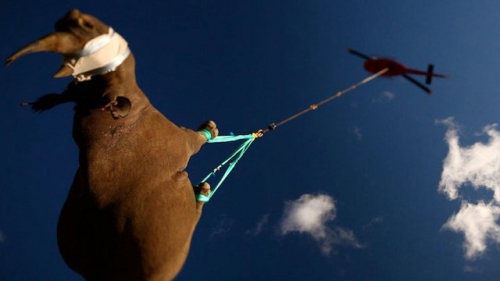 The rhinoceros has been a part of Buddhist practice and literature since the Pali Canon’s Khaggavisana Sutta, nicknamed the Rhinoceros Sutta. In it, practitioners are encouraged to “wander alone like a rhinoceros,” although the translation has been the subject of some controversy. You can read the entire sutta here, translated by Thanissaro Bhikkhu on Access to Insight. As Buddhism made its way across cultures and countries, the rhinoceros came with it, most notably in koan practice. For instance, read “Roshi Meets Rhino,” a 1993 article by Janwillem van de Wetering in which he wrestles with the koan, “Roshi meets Rhino: where did Roshi go?”
The rhinoceros has been a part of Buddhist practice and literature since the Pali Canon’s Khaggavisana Sutta, nicknamed the Rhinoceros Sutta. In it, practitioners are encouraged to “wander alone like a rhinoceros,” although the translation has been the subject of some controversy. You can read the entire sutta here, translated by Thanissaro Bhikkhu on Access to Insight. As Buddhism made its way across cultures and countries, the rhinoceros came with it, most notably in koan practice. For instance, read “Roshi Meets Rhino,” a 1993 article by Janwillem van de Wetering in which he wrestles with the koan, “Roshi meets Rhino: where did Roshi go?”
But now, a newer koan: where did Rhino go? Though Rick Bass wrote about the black rhinos of Namibia just a few months ago in our Fall 2011 issue, yesterday the International Union for Conservation of Nature declared one sub-species of the West African black rhino extinct. This Gawker article, which explains the photo that goes with this post (the short answer: it’s part of a rhino airlifting translocation project), has more detailed information.
Such serious news from the animal realm merits insights from dharma teachers who support the environment, such as Roshi Joan Halifax. There’s a brief but pithy interview with her on The Jizo Chronicles. From the interview:
JC: What social issue is close to your heart right now?
Roshi: All are interconnected…the environment; rights of the dying; care of caregivers; education and medical care for peoples of the Himalayas; prison work; those living on the margins of society, particularly kids. How about Burma, Somalia, Afghanistan, Libya, our streets, our neighborhoods, our own minds. We don’t have to look far — and we should look far as well.
JC: How does your dharma practice inform your involvement on that issue?
Roshi: Buddhist practice is the grounding for this work, this life, this way.
JC: If you could invite people to join you in taking one action on that issue, what would it be?
Roshi: Cease consuming, practice generosity.
And speaking of dharma practice, today is November 11, 2011: 11/11/11. (Also, did anyone notice? This post went up at 11:11:11.) Superstitions, coincidences, and bad movies aside, today’s date reminded me of ngondro, or the preliminary practices of Tibetan Buddhism. Traditionally someone engaging in these practices does 100,000 prostrations, 100,000 repetitions of the Vajrasattva mantra, 100,000 mandala offerings, and 100,000 guru yoga practices. But because our minds are as difficult to tame as the wind (or perhaps a wild rhinoceros) and is frequently not in the appropriate mindset for practice, ngondro-practitioners end up doing 111,111 of each practice in order to make up for any mistakes or incorrect approaches. It seems, then, that 11/11/11 is the perfect day to honor both the ngondro practices themselves and those Tricycle readers out there who are currently doing the preliminary practices or have completed them already. A big thank you to them and to anyone who is practicing on the long path of the dharma; the Tricycle staff sends their gratitude and support.
Thank you for subscribing to Tricycle! As a nonprofit, we depend on readers like you to keep Buddhist teachings and practices widely available.